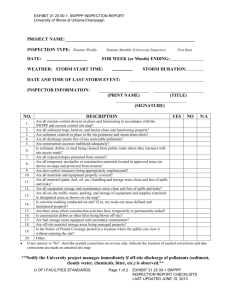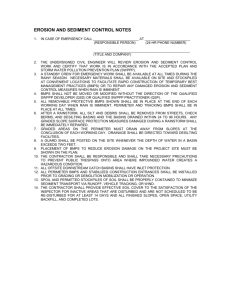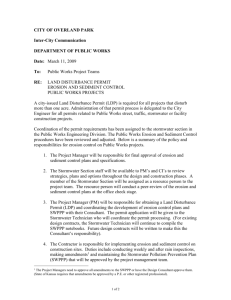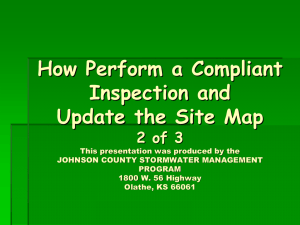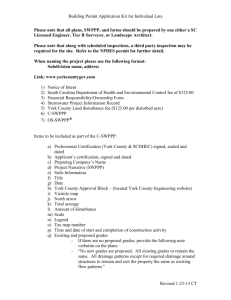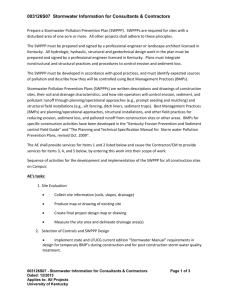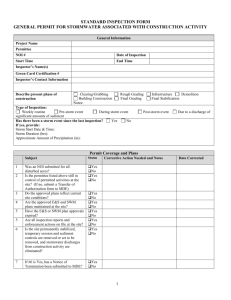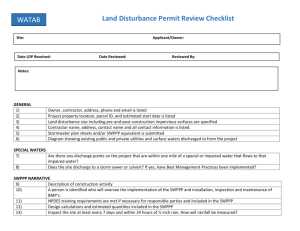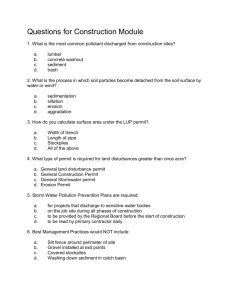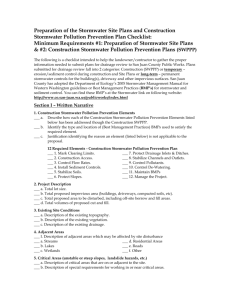Stormwater Pollution Prevention Plan Evaluation
advertisement
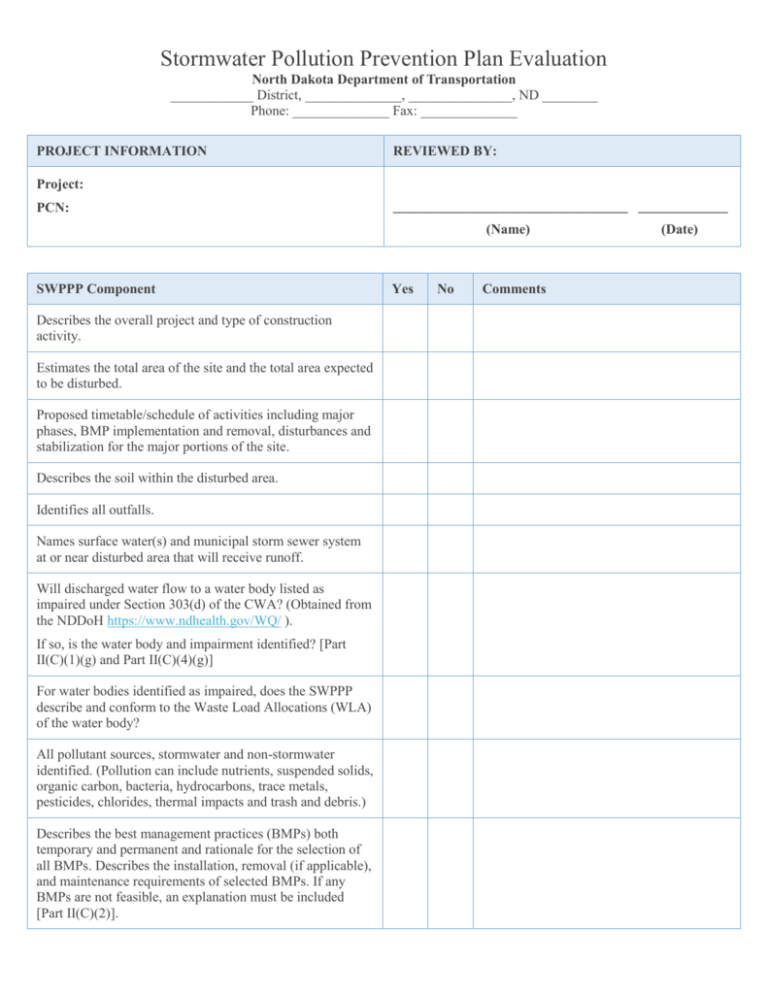
Stormwater Pollution Prevention Plan Evaluation North Dakota Department of Transportation ____________ District, ______________, _______________, ND ________ Phone: ______________ Fax: ______________ PROJECT INFORMATION REVIEWED BY: Project: PCN: __________________________________ _____________ (Name) SWPPP Component Describes the overall project and type of construction activity. Estimates the total area of the site and the total area expected to be disturbed. Proposed timetable/schedule of activities including major phases, BMP implementation and removal, disturbances and stabilization for the major portions of the site. Describes the soil within the disturbed area. Identifies all outfalls. Names surface water(s) and municipal storm sewer system at or near disturbed area that will receive runoff. Will discharged water flow to a water body listed as impaired under Section 303(d) of the CWA? (Obtained from the NDDoH https://www.ndhealth.gov/WQ/ ). If so, is the water body and impairment identified? [Part II(C)(1)(g) and Part II(C)(4)(g)] For water bodies identified as impaired, does the SWPPP describe and conform to the Waste Load Allocations (WLA) of the water body? All pollutant sources, stormwater and non-stormwater identified. (Pollution can include nutrients, suspended solids, organic carbon, bacteria, hydrocarbons, trace metals, pesticides, chlorides, thermal impacts and trash and debris.) Describes the best management practices (BMPs) both temporary and permanent and rationale for the selection of all BMPs. Describes the installation, removal (if applicable), and maintenance requirements of selected BMPs. If any BMPs are not feasible, an explanation must be included [Part II(C)(2)]. Yes No Comments (Date) SWPPP Component Identifies a person knowledgeable and experienced in the application of erosion and sediment control BMPs who will oversee the implementation of the SWPPP [Part II(C)(3)(a)]. Describes good housekeeping practices: litter, debris, chemicals, sediment tracking, dust reduction [Part II(C)(3)(b)]. Describes preventative maintenance and inspection practices of erosion and sediment control devices and equipment used or stored on site [Part II(C)(3)(c)]. Describes spill prevention and response procedures. Specific handling procedures, storage requirements, spill containment, cleanup procedures, and disposal must be identified and have leak protection [Part II(C)(3)(d)]. Outlines how employees and responsible parties shall be trained on the implementation of the SWPPP [Part II(C)(3)(e)]. Describes how concrete grindings and slurry will be managed [Part II(C)(3)(f)]. Describes dewatering activities planned at the site [Part II(C)(3)(g)]. Includes a DAILY inspection schedule for dewatering activities [Part II(C)(3)(g)(4)(a)]. Describes erosion and sediment controls and site stabilization methods for each major phase of site activity, addressing the selection of erosion and sediment controls and site stabilization methods [Part II(C)(4)(a)]. Describes sediment basins, or an appropriate combination of equivalent sediment controls such as smaller sediment basins and/or sediment traps, silt fences, etc. [Part II(C)(4)(b)]. Describes plan for temporary or permanent erosion protection and stabilization to be initiated immediately for all exposed soil areas where activities have been completed or temporarily ceased [Part II(C)(4)(c)]. Includes instructions for control methods to be installed and maintained in accordance with the manufacturer’s specifications, corrective actions, etc. [Part II(C)(4)(d)]. Describes how sediment deposition will be removed if sediment escapes from the site [Part II(C)(4)(e)]. Identifies permanent practices, if any, incorporated into the project to control pollutants in stormwater discharges Yes No Comments SWPPP Component occurring after construction operation have been completed [Part II(C)(5)]. Describes maintenance or clean out interval for sediment controls [Part II(C)(6)]. Contains a site inspection form and inspection log for use during weekly inspections or during storm water events [Part II(C)(7)]. The owner as well as all relevant contractors and subcontractors shall sign the SWPPP and it should list where on-site it will be kept throughout the project [Part II(C)(8)]. Yes No Comments SITE MAP In addition to the narrative portion of the SWPPP, a site map shall be included. Applicable topographic lines shall be shown. The site map must include: SWPPP Component Project boundaries Areas of ground disturbance during each phase of the project Areas where disturbance will not occur (avoidance areas, e.g. wetlands, critical habitat, Threatened and Endangered Species, etc.) Drainage patters including flow direction (run-on and runoff) Dividing lines, discharge points, and storm sewer system inlets the site drains to or may be affected by the activity Pre-existing and final grades Location of all temporary and permanent sediment and erosion controls during each phase Location of any stormwater conveyances such as: retention ponds, detention ponds, ditched, pipes, swales, stormwater diversions, culverts and ditch blocks Location of potential sources of pollution (e.g. portable toilets, trash receptacles, etc.) Location of soil stockpiles Identify steep slopes (15% or steeper) Surface waters, including aerial extent of wetland acreage Location of surface water crossings Locations where stormwater is discharged to surface waters Location of dewatering discharge points Locations of chemical treatment of stormwater will be performed, including discharge points Fueling locations, vehicle and equipment maintenance areas, designated wash water collection site, lubricant and chemical storage, paint storage, material storage, staging areas, and debris collection areas Location of any impervious surfaces upon completion of construction; and Where included as part of the project, the site maps for off-site concrete/asphalt batch plants, equipment staging areas, borrow sites or excavated fill material disposal sites. *If an item is not applicable, provide rationale describing why the item is not applicable to the activity. Yes No Comments
